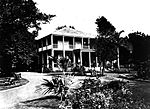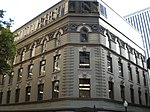First Hawaiian Center
1996 establishments in HawaiiKohn Pedersen Fox buildingsOffice buildings completed in 1996Skyscraper office buildings in HawaiiSkyscrapers in Honolulu

First Hawaiian Center is the second tallest building in the U.S. state of Hawaiʻi and the city of Honolulu, the largest city in the state. It is the world corporate headquarters of First Hawaiian Bank, the oldest and largest bank based in Hawaiʻi. The tower is one of the most well-known buildings in Honolulu, with a striking presence at the center of downtown Honolulu's skyline.
Excerpt from the Wikipedia article First Hawaiian Center (License: CC BY-SA 3.0, Authors, Images).First Hawaiian Center
Alakea Street, Honolulu Hawaii Capital Historic District
Geographical coordinates (GPS) Address Nearby Places Show on map
Geographical coordinates (GPS)
| Latitude | Longitude |
|---|---|
| N 21.307861111111 ° | E -157.86158333333 ° |
Address
Alakea Street 910
96813 Honolulu, Hawaii Capital Historic District
Hawaii, United States
Open on Google Maps








